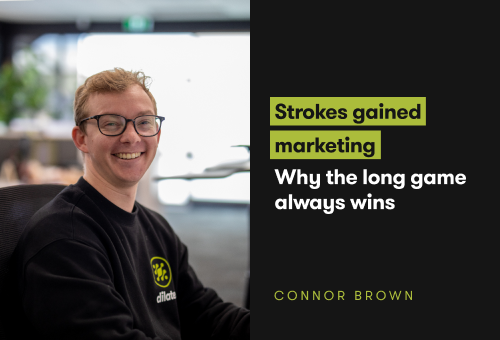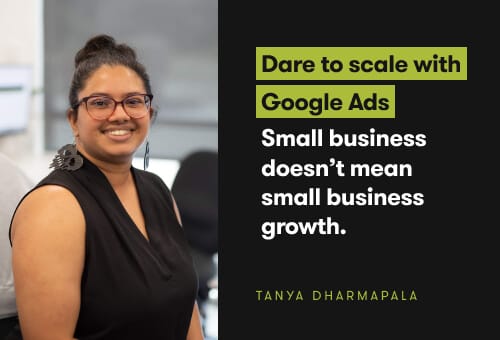
Strokes gained marketing: Why the long game always wins
“Drive for show, putt for dough.”
It’s one of those old golf sayings that gets passed down like gospel — my dad swore by it, and his dad before him. The idea behind it? You might look good smashing a drive off the tee, but it’s the final putt that wins you the money.
Turns out, it’s not quite that simple.
In golf, and in marketing, the real differentiator isn’t just what happens at the end. It’s what happens all the way through.
So what does golf’s most game-changing metric — strokes gained — have to do with marketing, and what can it teach us about modern data attribution?
The myth of the final shot: Why last-click attribution falls short
Most businesses still measure success using last-click attribution — giving all the credit to the final interaction before someone converts.
That might be:
- The sale that happened after someone clicked on a Google ad
- The download that came from an email campaign
- The contact form filled out after a remarketing banner
- The sign-up that followed a direct visit to your homepage
A simple way to measure? Yes.
An accurate view of your marketing efforts? Not even close.
Imagine crediting a great round of golf solely to the final putt. It’s absurd, right? You’d be ignoring the smart club choices, the calculated approach shots, and the pressure-handling drive off the tee that got you there in the first place.
That’s exactly what happens when we focus only on conversions. We ignore the impact of the awareness campaigns, the blog content that earned attention, or the social proof that built brand trust weeks earlier.
And the cost? Misallocated budget, a skewed view of performance, and teams chasing short-term wins at the expense of long-term brand building.
Strokes gained — A smarter way to measure performance
In golf, a system called strokes gained changed how players understand their performance. Instead of just counting how many shots it takes to finish a hole, it looks deeper — showing where a player is doing better or worse than average.
Every situation on the course has an average number of shots it should take to finish and ‘hole out’ from there. So, if most players need three shots to reach the hole from a certain distance, but you do it in two, you’ve ‘gained’ a stroke — meaning you performed better than average.
The formula looks like this:
Starting strokes – ending strokes – shots taken = strokes gained
For example: 3 – 1.5 – 1 = 0.5 strokes gained
In plain terms, it’s a way to measure how much value each action adds or takes away — not just the end result.
Negative numbers show where a golfer performed worse than average — they took more shots than expected. Positive numbers show where they performed better than average — they needed fewer shots than most.
Now, think about applying that same kind of insight to your marketing. Instead of only tracking outcomes, you can see which parts of your funnel are adding value and which are holding you back. That’s where real growth starts.
From tee to green: Mapping golf to marketing
We've mapped each stage of the golf game to the key stages of the marketing funnel (the same framework we use here at Dilate) to bring this analogy to life and show how every 'shot' in your marketing strategy plays a role in driving results.
| Golf component | Funnel stage | Objective | How value is created |
|---|---|---|---|
| Driving (Off the tee) | Awareness | Build visibility & attention | Memorable first impression, strong brand messaging, strategic reach to a relevant audience |
| Approach shots | Interest | Deepen understanding, build trust | Educational content, personalisation, positioning as a helpful expert |
| Short game (Chipping) | Desire | Overcome doubts, create emotional buy-in | Social proof, demos/trials, FAQs that build conviction |
| Putting | Action | Convert interest into revenue | Friction-free user experience, sharp CTAs, clear value propositions at the point of decision |
The long game builds differentiation
Just like in golf, the early stages of a marketing journey are where real competitive advantage is built.
A strong drive (the awareness stage) puts you in the right spot. A solid approach (the interest stage) sets up an easy finish. If you mess up early, no amount of putting will save the hole.
In marketing terms? If your brand isn’t showing up early and often with value, clarity and consistency, you're making it harder (and more expensive) to convert later.
“So, why should I invest in content that doesn’t convert today?”
Because it's laying the groundwork for conversions tomorrow — and every day after. Focusing only on conversions is like crediting a win to a final tap-in putt while ignoring the 200m drive that made it possible.
Customer journeys are messy - so measure smarter
Today’s customer journey isn’t a neat, linear funnel. It’s a maze of interactions, from Instagram Reels to Google searches, comparison blog posts to newsletter clicks. Google calls it the messy middle, and it’s where most decisions are shaped.
Data-driven attribution is built for that complexity.
It uses real data to assign value to each touchpoint based on its actual contribution — not just the last one. It’s the strokes gained of marketing: a way to pinpoint where your efforts are winning (or losing) across the entire funnel.
Your marketing scorecard: Measure what matters
Here’s how you can build your own scorecard, a framework that evaluates each stage of the funnel against your goals, and identifies where you're gaining or losing marketing ‘strokes’.
| Funnel stage | Key metrics (par) | Your score | Strokes gained/lost |
|---|---|---|---|
| Awareness | Reach, share of voice, branded search volume | ||
| Interest | Click-through rate, time on site, content depth | ||
| Desire | Lead magnet conversions, email engagement | ||
| Action | Conversion rate, cost per acquisition |
Playing like a pro: What marketers can learn from golf
Think beyond conversions.
Don’t just ask, what converted? Ask why, and what helped us get there?
Invest in the early game.
Build brand awareness and trust early — it's where differentiation compounds.
Diagnose, don’t guess.
Use data to see where you're winning or losing at each stage, and optimise accordingly.
Embrace the human side.
Strokes gained is all about performance, but golf is still a game of instinct, feel and finesse. The same goes for marketing. Data helps you play smarter, but creativity is what makes you unforgettable.
The wisdom that sticks
If there’s one lesson from golf to take into marketing, it’s this:
“Don’t just focus on the finish. Play the whole course with intent.”
Because long-term success — in golf, in marketing, in business — comes from consistency, strategy, and knowing that every shot counts.
















